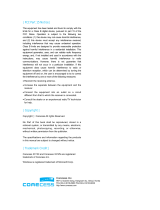
STU-R (CO) side................................................................................16
STU-C (CPE) side..............................................................................17
Console Configuration........................................................................17
3.3.5 Advanced Setup............................................................................18
SHDSL...............................................................................................18
WAN...................................................................................................18
Bridge.................................................................................................20
Route..................................................................................................20
NAT/DMZ............................................................................................23
Virtual Server......................................................................................24
3.3.6 Administration................................................................................25
Security..............................................................................................25
SNMP.................................................................................................26
Time Sync...........................................................................................27
Config Tool..........................................................................................28
Upgrade..............................................................................................29
Restart................................................................................................29
3.3.7 Status............................................................................................29
3.4 COMMAND LINE INTERFACE .....................................................................30
3.4.1 Multi-level password protection.....................................................31
3.4.2 Menu Driven Command Line Interface..........................................32
3.4.3 Command Line Interface Menu Tree.............................................32
3.4.4 Status............................................................................................38
3.4.5 Show.............................................................................................38
3.4.6 Write..............................................................................................38
3.4.7 Reboot..........................................................................................39
3.4.8 Ping...............................................................................................39
3.5 ADMINISTRATION ....................................................................................39
3.5.1 User Profile...................................................................................39
3.5.2 Security.........................................................................................40
3.5.3 SNMP............................................................................................40
3.5.4 Supervisor Password and ID.........................................................40
3.5.5 SNTP............................................................................................41
3.6 UTILITY .................................................................................................41
3.7 EXIT......................................................................................................41
3.8 SETUP...................................................................................................42
3.8.1 Mode.............................................................................................42
3.8.2 SHDSL..........................................................................................42




















